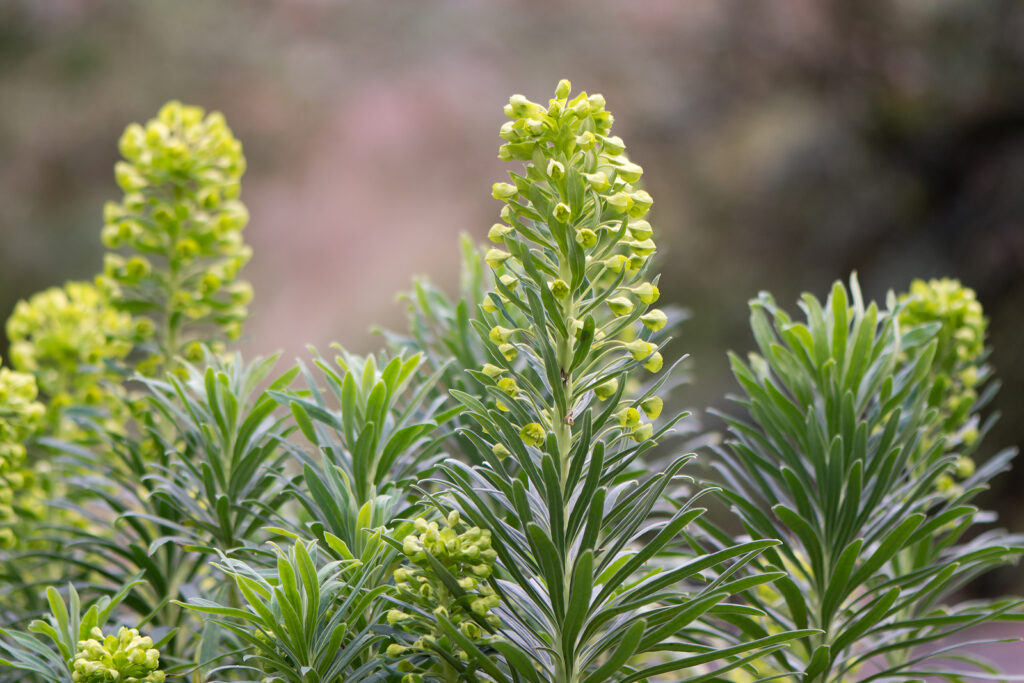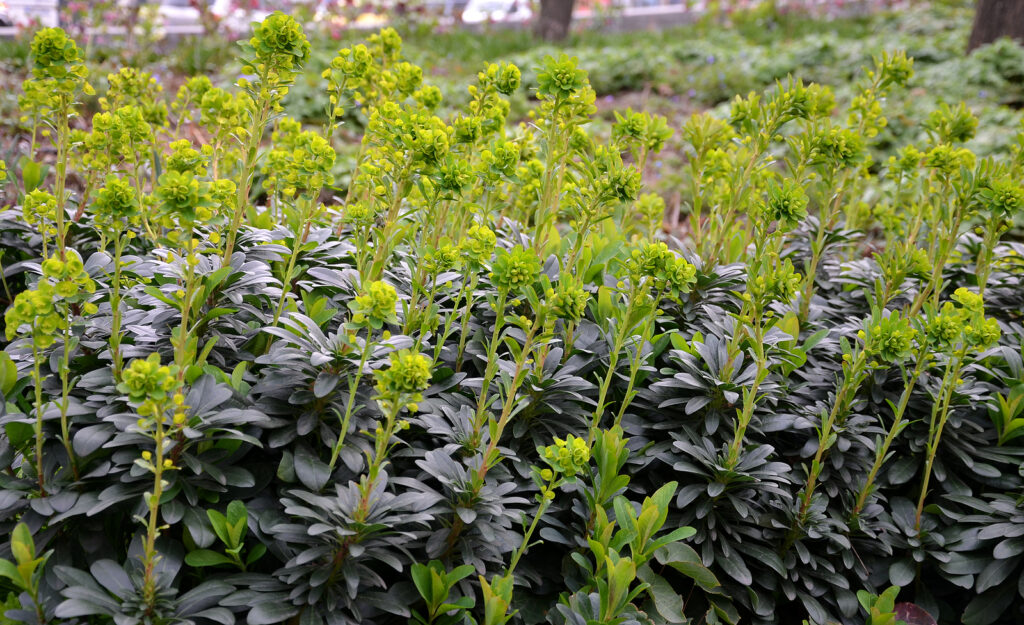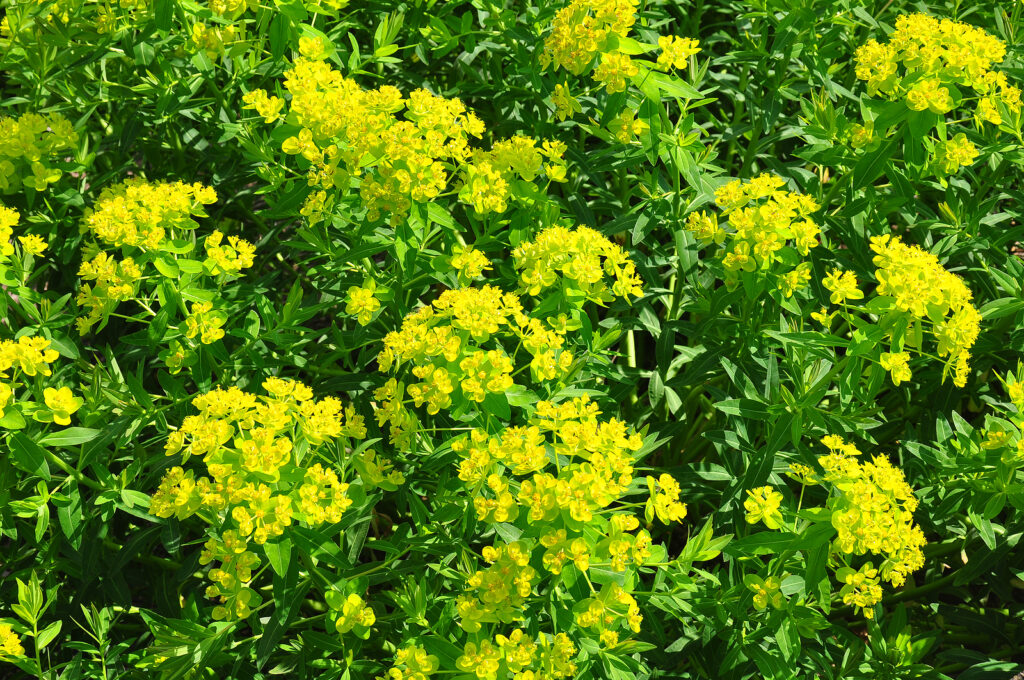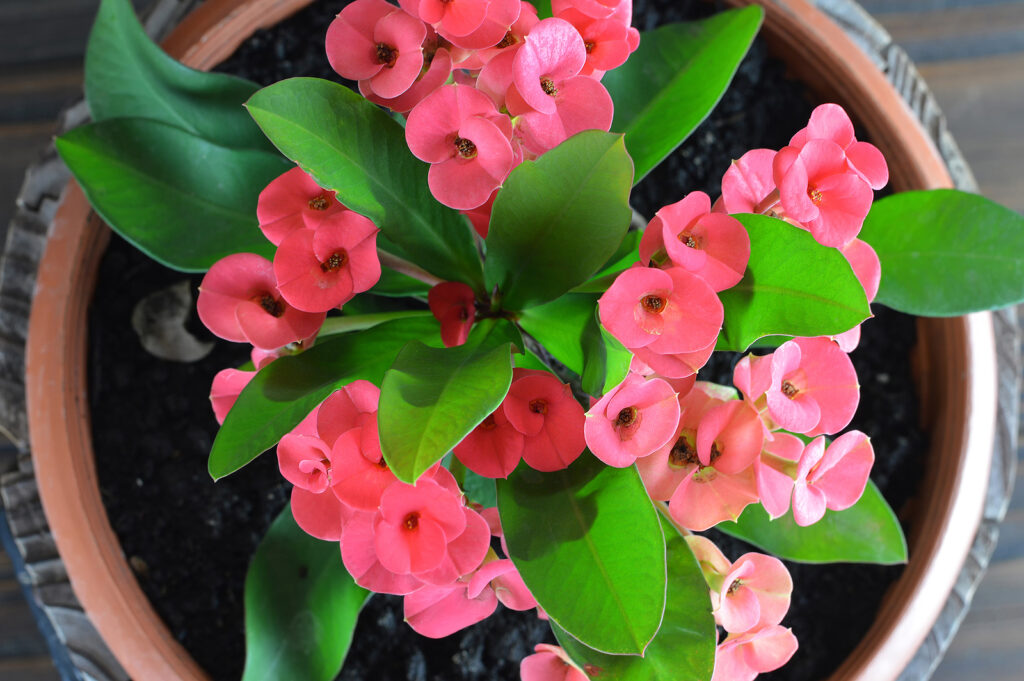Euphorbia is a varied genus of about 2,000 species of annuals, biennials, herbaceous perennials, shrubs, subshrubs, and trees. Members of the genus are widely distributed around the world.
Herbaceous Euphorbias–commonly called spurge– are a diverse group of plants, included are the holiday poinsettia, the spiny crown-of-thorns, and green-and-white snow-on-the-mountain.
Euphorbias are grown for their spring and summer flowers, handsome foliage colors, and often evergreen leaves. Euphorbias have “showy” flowers; Euphorbia’s flowers are actually colorful petal-like bracts that surround the true flowers.
Many euphorbias can be used in beds and borders where their chartreuse foliage and yellow inflorescences are almost immediately recognizable. Others are often grown as houseplants.
Several of the most common Euphorbias are listed below.
Special note: Euphorbia stems contain a milky sap that flows when the stems are cut or damaged; the sap can irritate the skin. Dip the stems of cut Euphorbia flowers in boiling water to seal in the sap.

Get to Know Euphorbia
- Plant type: Shrub, perennials, annuals, succulents
- Growing zones and range: Zones 4 to 9 depending on the variety
- Hardiness: Protect Euphorbias from the winter cold
- Height and width: Many euphorbias mimic cacti and should be treated as such.
- Foliage: Leaves are variable and often short-lived.
- Flowers: True flowers are surrounded by showy bracts; in most species, the bracts are yellow-green; after the true flowers fade the bracts usually persist.
- Bloom time: Spring and summer
- Uses: Beds and borders
- Common name: Spurge, cushion spurge
- Botanical name: Euphorbia
- Family name: Euphorbiaceae
- Origin: Euphorbias are widely distributed around the world

Where to Plant Euphorbia
- Grow euphorbias in full sun or light shade.
- Euphorbias will grow in average, well-drained soil.
- Most euphorbias are drought tolerant once established.
Euphorbia Uses and Companions
- Use Euphorbias in the foreground of formal beds and borders.
- Many herbaceous Euphorbias are suitable for a rock garden a mixed or shrub border, or a woodland garden.
- Succulent species are suitable for a dry, tropical garden.
- Good garden companions for Euphorbia include Artemisia Aurinia saxatilis, Limonium latifolium, Linum, Nepeta, Oenothera.

When to Plant Euphorbia
- Set perennial euphorbia in the garden after the last frost in spring.
- Start annual euphorbias from seed indoors 6 to 8 weeks before the last frost in spring.
Planting and Spacing Euphorbia
- Spacing varies by variety.

How to Water and Feed Euphorbia
- Keep the soil evenly moist, but not wet.
- Fertilize euphorbia in spring with an all-purpose organic fertilizer.
Euphorbia Pests and Diseases
- Euphorbias are usually trouble free. A few may be susceptible to powdery mildew.

Euphorbia Propagation
- Propagate perennial euphorbias by division, by cuttings from shoots that appear at the base of the plants in spring, and by tip cuttings take in summer.
- Annual euphorbia can be propagated by seed. Annual euphorbias self-sow.
- Euphorbia seeds germinate in 10-14 days at 65°-75°F (18°-24°C). Germination can be erratic.

Euphorbia Varieties to Grow
- Euphorbia amygdaloides: Perennial grows to 3 feet (.9m) tall; resemble E. characias but smaller; best in sun; dies back in winter; bright green flowers; cultivar ‘Purpurea’ has purple shaded foliage.
- E. charaias: Evergreen perennial; upright, dome-shaped bush to 4 feet (1.2m) tall; narrow blue-green leaves; densely clustered flowers are chartreuse or lime green; E. c. wulfenii is a common form; hardy to 10°F (-12°C).
- E. corollata. Slender branching stems form loose airy mound to 3 feet with willowlike bluish green leaves and spreay of white flower; hardy to -35°F (-37°C).
- E. cotinifolia: Caribbean copper plant: Evergreen shrub or tree; long-stalked leaves; loose flower clusters have small white bracts; likes heats; cultivar ‘Atro-purpurea’ has wine-red leaves.
- E. cyparissias: Perennial grows to 16 inches (40cm) tall from rhizomes; narrow 1.5-inch leaves are crowded on stem creating a feathery effect; clusters of chartreuse yellow flowers; good ground cover; may become dormant in winter.
- E. dulcis: Rhizomatous perennial grows to 12 inches (30cm) tall with dark green or bronze-green leaves; small clusters of greenish-yellow flowers in early summer.
- E. epithymoides: Perennial with rounded form; each stem ends in a cluster of tiny flowers surrounded by bright yellow bracts has the effect of a gold mound; spring bloomer; fall color is yellow to orange-red; goes dormant in winter; short-lived but reseeds.
- E. fulgens, scarlet plume: Evergreen shrub grows 3 to 4 feet (.9-1.2m) tall; drooping branches with narrow leaves; clusters of bright scarlet flowers in winter.
- E. griffithii: Perennial; erect stems to 3 feet (.9m) tall; narrow, medium-green leaves with clusters of brick red or orange bracts; spreads by creeping roots; does back in winter; hardy to -20°F (-29°C)
- E. heterophylla, Mexican fire plant: Annual grows to 3 feet (.9m) tall with bright green leaves resembling those of poinsettia; upper leaves blotched bright red and white; use in hot, dry borders.
- E. lathyris, gopher plant: Biennial said to repel gophers; stems have caustic juice; grows as a tall single stem to 5 feet (1.5m) with long narrow leaves and clusters of yellow flowers at the top.
- E. marginata, snow-on-the-mountain: Annuals with light green leaves stripped and margined with white; use in contrast to flowers in summer; plants can become rangy.
- E. martini: Evergreen perennial resembles E. characias with dense chartreuse, brown-centered flowers in late winter.
- E. milii (E. splendens), crown of thorns: Woody evergreen perennial subshrub; sparsely leafed; grows 3 to 4 feet (.9-1.2m) tall with long, sharp thorns; roundish thin light green leaves; bright red bracts.
- E. myrsinites: Evergreen perennial with floppy central crown rises to 12 inches (30cm); stiff blue-gray leaves; flattish clusters of chartreuse to yellow flower; hardy to -20°F (-29°C).
- E. obesa, baseball plant: Evergreen succulent; house plant; solid, fleshy, gray-green sphere with brownish stripes that resemble stitching on a baseball.
- E. palustris: Perennial grows to 3 feet (.9m) tall with medium green leaves; wide branching with a cluster of yellow flowers in spring.
- E. polychroma: cushion spurge: Compact perennial grows to 2 feet (.6) tall and wide; bright yellow-green flowers in early spring; hardy to -30°F (-34°C).
- E. pulcherrima, poinsettia: Semi-evergreen; showy petal-like bracts with true yellow flowers in centers; red bract form most familiar; can be adapted to the garden.
- E. rigida: Evergreen perennial or subshrub grows to 2 feet (.6) tall; fleshy gray-green narrow pointed leaves; domed flower clusters are chartreuse fading to pink.
- E. robbiae, Mrs. Robb’s bonnet: Evergreen perennial less than 12 inches (30cm) tall; closely set leathery dark green leaves; pale lime green flower clusters.
- E. seguierana niciciana: Evergreen perennial grows to18 inches (45cm) tall with blue-gray narrow leaves and chartreuse flowers in late winter.
- E. tirucalli, milkbush, pencilbush:Tree or large shrub to 30 feet tall, usually smaller; single or multi-trunk; light green, pencil-thick succulent branches with no sign of a leaf.



